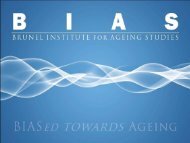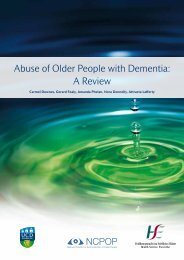Public Perceptions of Older People A literature review
Review 1 PP OP.pdf - National Centre for the Protection of Older ...
Review 1 PP OP.pdf - National Centre for the Protection of Older ...
Create successful ePaper yourself
Turn your PDF publications into a flip-book with our unique Google optimized e-Paper software.
7.7.6 Elder abuse and neglect<br />
Ageism and negative perceptions <strong>of</strong> older people have been purported to<br />
contribute to the abuse and mistreatment <strong>of</strong> older people (Quinn & Tomita<br />
1997). According to the Report <strong>of</strong> the Working Group on Elder Abuse entitled<br />
‘Protecting Our Future’, elder abuse is defined as:<br />
A single or repeated act or lack <strong>of</strong> appropriate action occurring within<br />
any relationship where there is an expectation <strong>of</strong> trust which causes<br />
harm or distress to an older person or violates their human and civil<br />
rights (WGEA 2002, p.25).<br />
Although the figures are currently unknown in Ireland, a national UK<br />
prevalence study on elder abuse has reported a 2.6% rate <strong>of</strong> abuse among<br />
older people (O’Keeffe et al. 2007).<br />
While specific research linking perceptions with elder abuse is limited, a recent<br />
qualitative study on elder abuse and neglect carried out by the Families<br />
Commission in New Zealand found that participants believed older people to<br />
be fundamentally undervalued and not respected in society as a whole (Peri et<br />
al. 2008). Pervasive prejudice against older people has been reported to result<br />
from widespread myths and stereotypes about the old and the process <strong>of</strong><br />
ageing (Quinn & Tomita 1997). Peri et al. (2008) found that participants who<br />
had suffered mistreatment expressed strong emotion about the ageism, abuse<br />
and lack <strong>of</strong> respect they experienced (Peri et al. 2008).<br />
Podnieks (2006) argued that negative social and personal attitudes are closely<br />
related to the social exclusion <strong>of</strong> older people which can easily lead to abusive<br />
situations. For example, a disproportionate availability <strong>of</strong> services for children<br />
or adults compared to the older population sends a message to society that<br />
older people are not worthy <strong>of</strong> the same health and social protections as other<br />
age groups. Thus ageist attitudes, whilst not direct causes in and <strong>of</strong><br />
themselves, can lead to a tolerance and acceptance <strong>of</strong> abuse, and create an<br />
atmosphere that paves the way for the abuse and neglect <strong>of</strong> older people<br />
(Quinn & Tomita 1997; HSE 2009).<br />
Ageist attitudes in the community and the marginalisation <strong>of</strong> older people may<br />
also present barriers toward the reporting <strong>of</strong> abuse (Saunders 2008).<br />
Negative perceptions and stereotypes <strong>of</strong> older people may hinder legislation<br />
and lead to scepticism about claims <strong>of</strong> elder abuse (Golding et al. 2005).<br />
Saunders (2008) reported that signs <strong>of</strong> abuse are too <strong>of</strong>ten ignored, or<br />
45









